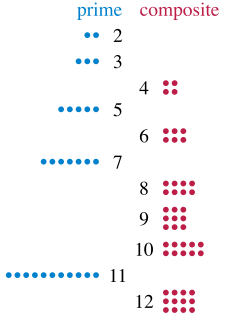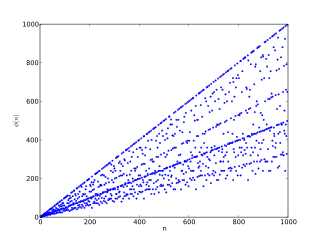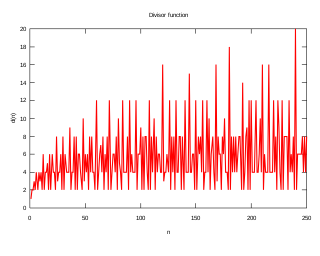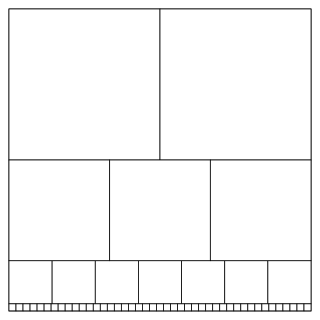
In mathematics, and particularly in number theory, N is a primary pseudoperfect number if it satisfies the Egyptian fraction equation
Contents
where the sum is over only the prime divisors of N.

In mathematics, and particularly in number theory, N is a primary pseudoperfect number if it satisfies the Egyptian fraction equation
where the sum is over only the prime divisors of N.
Equivalently, N is a primary pseudoperfect number if it satisfies
Except for the primary pseudoperfect number N = 2, this expression gives a representation for N as the sum of distinct divisors of N. Therefore, each primary pseudoperfect number N (except N = 2) is also pseudoperfect.
The eight known primary pseudoperfect numbers are
The first four of these numbers are one less than the corresponding numbers in Sylvester's sequence, but then the two sequences diverge.
It is unknown whether there are infinitely many primary pseudoperfect numbers, or whether there are any odd primary pseudoperfect numbers.
The prime factors of primary pseudoperfect numbers sometimes may provide solutions to Znám's problem, in which all elements of the solution set are prime. For instance, the prime factors of the primary pseudoperfect number 47058 form the solution set {2,3,11,23,31} to Znám's problem. However, the smaller primary pseudoperfect numbers 2, 6, 42, and 1806 do not correspond to solutions to Znám's problem in this way, as their sets of prime factors violate the requirement that no number in the set can equal one plus the product of the other numbers. Anne (1998) observes that there is exactly one solution set of this type that has k primes in it, for each k ≤ 8, and conjectures that the same is true for larger k.
If a primary pseudoperfect number N is one less than a prime number, then N × (N + 1) is also primary pseudoperfect. For instance, 47058 is primary pseudoperfect, and 47059 is prime, so 47058 × 47059 = 2214502422 is also primary pseudoperfect.
Primary pseudoperfect numbers were first investigated and named by Butske, Jaje, and Mayernik (2000). Using computational search techniques, they proved the remarkable result that for each positive integer r up to 8, there exists exactly one primary pseudoperfect number with precisely r (distinct) prime factors, namely, the rth known primary pseudoperfect number. Those with 2 ≤ r ≤ 8, when reduced modulo 288, form the arithmetic progression 6, 42, 78, 114, 150, 186, 222, as was observed by Sondow and MacMillan (2017).

In mathematics, the Euclidean algorithm, or Euclid's algorithm, is an efficient method for computing the greatest common divisor (GCD) of two integers (numbers), the largest number that divides them both without a remainder. It is named after the ancient Greek mathematician Euclid, who first described it in his Elements . It is an example of an algorithm, a step-by-step procedure for performing a calculation according to well-defined rules, and is one of the oldest algorithms in common use. It can be used to reduce fractions to their simplest form, and is a part of many other number-theoretic and cryptographic calculations.
In mathematics, the classic Möbius inversion formula is a relation between pairs of arithmetic functions, each defined from the other by sums over divisors. It was introduced into number theory in 1832 by August Ferdinand Möbius.

A prime number is a natural number greater than 1 that is not a product of two smaller natural numbers. A natural number greater than 1 that is not prime is called a composite number. For example, 5 is prime because the only ways of writing it as a product, 1 × 5 or 5 × 1, involve 5 itself. However, 4 is composite because it is a product in which both numbers are smaller than 4. Primes are central in number theory because of the fundamental theorem of arithmetic: every natural number greater than 1 is either a prime itself or can be factorized as a product of primes that is unique up to their order.

In number theory, a perfect number is a positive integer that is equal to the sum of its positive divisors, excluding the number itself. For instance, 6 has divisors 1, 2 and 3, and 1 + 2 + 3 = 6, so 6 is a perfect number.

In number theory, Euler's totient function counts the positive integers up to a given integer n that are relatively prime to n. It is written using the Greek letter phi as or , and may also be called Euler's phi function. In other words, it is the number of integers k in the range 1 ≤ k ≤ n for which the greatest common divisor gcd(n, k) is equal to 1. The integers k of this form are sometimes referred to as totatives of n.

In number theory, a semiperfect number or pseudoperfect number is a natural number n that is equal to the sum of all or some of its proper divisors. A semiperfect number that is equal to the sum of all its proper divisors is a perfect number.

In number theory, a weird number is a natural number that is abundant but not semiperfect.

An Egyptian fraction is a finite sum of distinct unit fractions, such as

In mathematics, and specifically in number theory, a divisor function is an arithmetic function related to the divisors of an integer. When referred to as the divisor function, it counts the number of divisors of an integer. It appears in a number of remarkable identities, including relationships on the Riemann zeta function and the Eisenstein series of modular forms. Divisor functions were studied by Ramanujan, who gave a number of important congruences and identities; these are treated separately in the article Ramanujan's sum.

A powerful number is a positive integer m such that for every prime number p dividing m, p2 also divides m. Equivalently, a powerful number is the product of a square and a cube, that is, a number m of the form m = a2b3, where a and b are positive integers. Powerful numbers are also known as squareful, square-full, or 2-full. Paul Erdős and George Szekeres studied such numbers and Solomon W. Golomb named such numbers powerful.
A unit fraction is a rational number written as a fraction where the numerator is one and the denominator is a positive integer. A unit fraction is therefore the reciprocal of a positive integer, 1/n. Examples are 1/1, 1/2, 1/3, 1/4, 1/5, etc.

In number theory, a practical number or panarithmic number is a positive integer n such that all smaller positive integers can be represented as sums of distinct divisors of n. For example, 12 is a practical number because all the numbers from 1 to 11 can be expressed as sums of its divisors 1, 2, 3, 4, and 6: as well as these divisors themselves, we have 5 = 3 + 2, 7 = 6 + 1, 8 = 6 + 2, 9 = 6 + 3, 10 = 6 + 3 + 1, and 11 = 6 + 3 + 2.

In number theory, Znám's problem asks which sets of k integers have the property that each integer in the set is a proper divisor of the product of the other integers in the set, plus 1. Znám's problem is named after the Slovak mathematician Štefan Znám, who suggested it in 1972, although other mathematicians had considered similar problems around the same time. One closely related problem drops the assumption of properness of the divisor, and will be called the improper Znám problem hereafter.
A Giuga number is a composite number n such that for each of its distinct prime factors pi we have , or equivalently such that for each of its distinct prime factors pi we have .

In number theory, Sylvester's sequence is an integer sequence in which each term of the sequence is the product of the previous terms, plus one. The first few terms of the sequence are
In mathematics, a natural number a is a unitary divisor of a number b if a is a divisor of b and if a and are coprime, having no common factor other than 1. Thus, 5 is a unitary divisor of 60, because 5 and have only 1 as a common factor, while 6 is a divisor but not a unitary divisor of 60, as 6 and have a common factor other than 1, namely 2. 1 is a unitary divisor of every natural number.
In mathematics, a Størmer number or arc-cotangent irreducible number, named after Carl Størmer, is a positive integer n for which the greatest prime factor of n2 + 1 is greater than or equal to 2n.
In number theory, the Erdős–Moser equation is